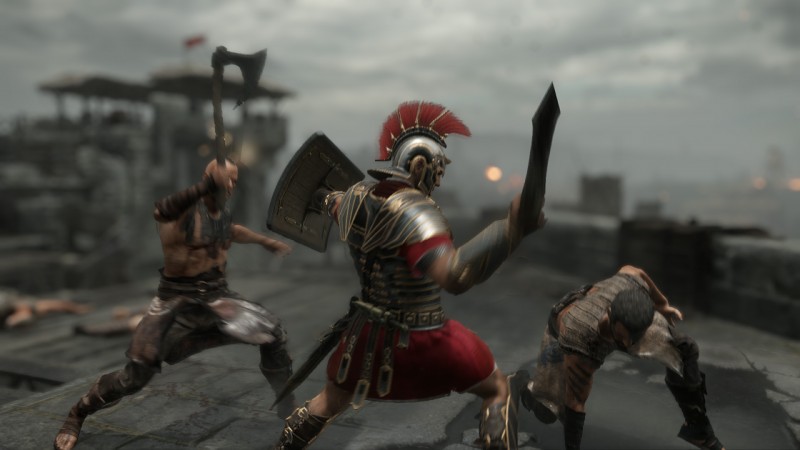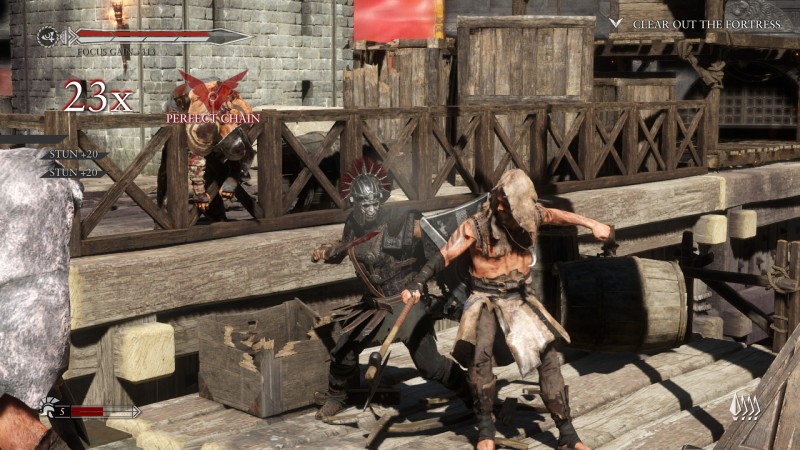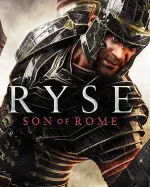Our extra-large special edition is here. Subscribe today and receive the 25% longer issue at no extra cost!
Ryse: Son of Rome Review

When protagonist Marius Titus lowers a foe’s defenses and goes in for the kill, the speed of the fray slows to a crawl, giving us a good look at why Ryse: Son of Rome will simultaneously draw gawking glances and be rendered unappealing.
In this measured moment, we see Marius’ segmented armor shift with the contortion of his body, the cloth beneath it rippling as he raises his arm, and the skin on his face tightening as his mouth opens in a furious rage before he slits his opponent’s throat. This spectacle is every bit as breathtaking as it is brutal, standing tall as a showpiece of next-generation technology. But what hand did the player have in this execution? Little to none.
All of Ryse’s final blows are delivered through timed button presses, prompted by flashing colors on the victim’s body. These visual cues represent the colors on the controller’s face buttons. Successfully hitting the correct sequence rewards the player with the choice of additional experience points, a damage boost, health replenishment, or Focus. The only penalties for hitting the wrong button or not hitting a button at all are a lower rating and less of the aforementioned rewards. Marius won’t botch the kill, and the opponent won’t counter the attack. This entire animation sequence is scripted and it’s going to play out exactly the same no matter how much you interact with it.
Since experience points are valuable and used to upgrade Marius’ health, Focus meter, and projectile supply, it’s in the player’s best interest to initiate these execution sequences and play the awful little game of Simon Says. This leads to the tiring monotony of watching the animations play out. While many of the execution animations repeat in standard combat circumstances, some battlefields do allow the player to initiate an environmental kill. Marius will slam someone against a rock and send his sword through them, drown a downed soldier in a shallow pool, toss an attacker off of a cliff, and use a wall of spikes to create a grisly display.

This perplexing execution design completely derails what is otherwise a respectable brawling system. Marius doesn’t have a wealth of combos to unleash, and is more a student of perfect timing who looks for small attack windows. Enemies often swarm him from all sides, and are quick to engage if he leaves himself open as he attacks another adversary. The player has the ability to quickly transition to a shield block mid-strike to repel a flanking attack. These encounters are intense, and the mixture of different enemy types within them requires strategy and evasive positioning.
Some foes deliver both blockable and unblockable attacks, meaning you have to act quickly to determine whether to use your shield or an evasive roll. Factoring in when to use your focus power – a state of rage that allows Marius to quickly slash any adversary without first having to reveal their weaknesses – is another layer of strategy that is carefully balanced and nicely designed. You can bring two enemies to the brink of death then initiate a finisher that drops both of them at once. I enjoyed most of the bouts…until I was called upon to perform a finisher. The thrill of combat is sapped at that point.

Marius occasionally is tasked with mounting a ballista to deal with approaching bandit waves. These sequences end up being unintentionally comedic, given just how quickly Marius fires off shots to send enemies tumbling to the ground. In many of the standard combat encounters, Marius can hurl spears at his assailants using a crude and unreliable aiming mechanic. Bandits sometimes don’t react to being hit, and run around goofily with a four-foot piece of wood jutting out of their bodies.
When the Roman army is on the move, Marius can unite with his fellow shield carriers to create a moving wall to combat archers. The gameplay used for this setup is incredibly simple: Move forward, hold the shield up to block arrows, return a volley of your own, and move on. In some of these sequences, you march aimlessly through caves and openings with nothing happening. After a long stretch, you eventually confront another archer legion.

All of Ryse’s action is framed with a cinematic eye. The camera is always in the right place to capture the enormous scale of some of the conflicts, give players close-up shots of devastating sword slices (complete with exposed bones), and panning to capture the drama in a story sequence.
Marius’ tale is an encyclopedia of clichés, touching on most of the hallmark moments seen in films depicting this era. It starts on a somber note with Marius losing his family to bandits that are invading his home and immediately shifts gears to a lust for revenge. He remains a boiling pot of rage all the way up to the final moments. I thought the story was a fun ride, filled with despicable politicians who get their dues spread across a nice selection of beautifully realized locations.
From warships at sea to the luxuries found in palaces, Crytek gives us a detailed look at Rome as it was. I often would take the time to pan the camera around the environments to soak in all of their impressive details. The only setting that veers into the realm of fantasy is the Colosseum. With a mechanized floor that raises plates containing wilderness, wooden structures, death traps, and a wild variety of things, you’d think this arena was created by GLaDOS or is seconds away from transforming into Unicron. It’s ridiculous, and just happens to be the setting for the game’s two-player cooperative component. You and a friend can enter this battle contraption to fell waves of enemies and complete missions to earn currency that can be exchanged for booster packs filled with new armors and healing items. Ryse’s co-op is a good time, delivering plenty of maps and playlists and a decent challenge. Again, though, the combat falls back on the unwanted execution moves crutch. The currency players earn is miniscule at best, shining a bad light on the ability to purchase more gold through microtransactions.
When I show my friends what Xbox One is capable of graphically, I’m going to pop in Ryse. The visuals are breathtaking, but the gameplay flips on a dime between being legitimately fun and downright bad. There is no middle ground. It’s very much the extreme of both.

Get the Game Informer Print Edition!
Explore your favorite games in premium print format, delivered to your door.
- 10 issues per year
- Only $4.80 per issue
- Full digital magazine archive access
- Since 1991










